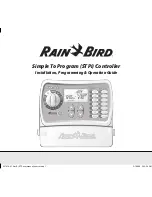
The injected frequency
f
inj
of the square wave, is a set value, deviating from the fundamental
frequency (50 or 60 Hz). The injected frequency can be set within the range 50 – 250 Hz with
recommend value 87 Hz in 50 Hz systems and 103 Hz in 60 Hz systems.
If the machine (generator) is stationary running (a few seconds or more) on 1/3 of the injection
frequency, the injection function will start to send errors. Therefore, 1/3 of the injection frequency
will not be used for spinning reserve, either the machine frequency or the injection frequency has
to be changed. The error occurs because the 3
rd
harmonic of the machine is on top of the injection
frequency and causes interference.
For example, if the injection frequency is 87Hz and the fundamental frequency of machine is on
87/3 = 29Hz, then the 3
rd
harmonic of machine is 87Hz, which can cause injection interference
errors.
The solution is to either change machine frequency or injection frequency.
The reference impedance can vary depending on the operational state. The reason for this can be
the following:
•
The influence from the impedance
Z
mT
will be different when the generator is stand-still and
when it is in operation
•
The capacitance to ground will vary if the generator breaker is open or closed
•
The capacitance will vary if the generator is energized or not depending on stator end winding
corona protection
•
Non-linearity of used injection transformer, different properties at low and high total voltage
and temperature changes
•
Impedance to ground is affected by auxiliary loads connected between generator and unit
transformer. If these loads vary, the estimated ground fault resistance will be affected.
All components that have a zero-sequence connection to the generator are sensed and may thus
influence the measured value. Hence, connection or disconnection of equipments within the zero-
sequence reach of the 100% stator earth-fault protection may require an additional reference
impedance with appropriate logic control.
Any change (for example, replacement of components during maintenance) inside the zero-
sequence reach of the function may affect the accuracy of the protection function, leading to the
need of a new calibration.
The difference from the first reference impedance is identified by monitoring impedance (
RAVE +
j
XRAVE) during different operation modes. This impedance is available as a service value from the
stator function both on built-in HMI and in ICT tool. If the difference is significant more than one
reference impedance is required. In the ICT up to five different sets of reference impedances can
be derived during commissioning for different states of operation and downloaded to the
protection function as different values of the reference impedance;
RefRn and RefXn where n = 1, 2,
and up to 5. Switching of reference impedance can be made automatically.
During commissioning ICT also makes “cross-calculations” between acquired references, giving
basically the calculated fault resistance between each existing reference combination. This would
be the fault resistance measured by the function when the reference change occurs from one
reference to another if the real generator impedance stays the same, in other words a worst case
scenario.
RMS voltage (rmsVolt) value at the injection point can be used for detecting when a reference
needs to be changed and logical outputs can be set to reflect whether the RMS voltage is higher or
lower than a prescribed value. There is one such output for the voltage signal. It is advantageous
Section 7
1MRK 502 066-UUS B
Impedance protection
428
Technical manual
Summary of Contents for Relion 670 series
Page 1: ... RELION 670 SERIES Generator protection REG670 Version 2 1 ANSI Technical manual ...
Page 2: ......
Page 48: ...42 ...
Page 62: ...56 ...
Page 182: ...176 ...
Page 692: ...686 ...
Page 726: ...720 ...
Page 1014: ...1008 ...
Page 1242: ...1236 ...
Page 1362: ...1356 ...
Page 1386: ...1380 ...
Page 1422: ...1416 ...
Page 1431: ...1425 ...
















































